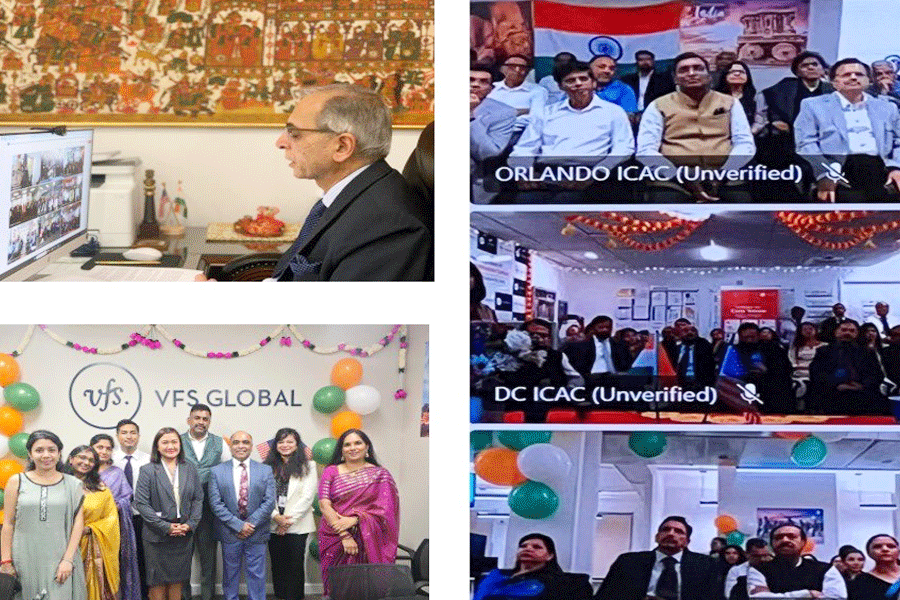 |  |
| Digital prints of “Tapis Mogol” or Safar-Nama in the Indian Museum corridor. (Right) Lotika Varadarajan at the opening of the exhibition last Friday. Picture by Biswarup Dutta | |
A priceless, tattered fabric in a museum can speak volumes for the cross-currents of culture which produced it and throw light on the international trade relations that prevailed at the time of its production.
Safar-Nama: Journeys through a Kalamkari Hanging, an exhibition of digital prints of an ancient painted fabric piece in the kalamkari tradition that prevailed in the Coromandel Coast and is now housed at the Museum of Printed Textiles of Mulhouse in France, along with Continuing Traditions, a show of contemporary artists whose works can relate to it, was opened in the first-floor corridor of the Indian Museum by tourism minister Bratya Basu on Wednesday.
The exhibition, organised in collaboration with Akar Prakar, Ambedkar University, the West Bengal Craft Council and Alliance Francaise du Bengale, and curated by Lotika Varadarajan, an eminent ethno-historian working in the areas of traditional knowledge systems, is about a length of chintz 230cmX180cm known as “Tapis Moghol” whose exact provenance and date of production are not clearly known.
The digital prints were displayed on the walls and columns adjacent to the staircase on the first floor. Contemporary works by Jayashree Chakravarty, Aditya Basak, Paula Sengupta, Archana Hande and Shrabani Roy were displayed in one corner, and on the day of the inauguration they were hardly visible because there was no proper lighting.
The next day the museum staff had covered the works with bubble wrap because they were working and dust was flying around. This is the first time that the institution has allowed a private gallery — Akar Prakar — to use its premises as a venue. Little or nothing could be heard of the speeches made on the occasion save a loud boom, thanks to reverberations caused by the super-high ceilings.
The seminar held the next day unravelled the mystery of “Tapis Moghol”, which, Surajit Sarkar, a consultant with Ambedkar University in Delhi, felt should be renamed “Safar-Nama” for the fabric was neither a “tapis” or carpet, nor was it Mughal. The digital prints have already toured other Indian cities and the show is here, thanks to the efforts of Ruby Palchoudhury representing Crafts Council.
Lotika Varadarajan explained that Safar-Nama was a more apt name as it represented the travel of ideas and motifs. Details of the motifs on the rectangular fabric were projected bringing out the element of fantasy in it. There were chintz motifs, which were not naturalistic as the artisans had never seen these. There were floral borders on two sides. From such evidence it could be concluded that it was a canopy and not a carpet with borders on all four sides.
She focused on the innermost part of the fabric, which was “cheerfully weird” with its stylised Ganesha and elephants, a bovine creature and a horse all composed of realistically playful monkeys. The standalone peacock too was realistic. There were besides the mythical Yali and a fowl that could be the Simurgh.
After seeing the central medallion, an Iranian scholar felt it had the connotation of the Garden of Paradise. There are also Indonesian motifs in it. Varadarajan indicated the point at which two pieces of the cloth had been sewn together to make a canopy. It was not dated but she felt it belonged to early 18th century, and she saw a Dutch connection with Tranquebar next door.
Surajit Sarkar said there were conjectures on why “Tapis” was made some time between 1670 to 1710. It is not known exactly how it reached Mulhouse in 1957. He stressed that the idea of fantasy and Tropical Paradise were not unknown to Europe and projected some images from Persia that Europeans were already familiar with. It has been conjectured that it is a sampler meant for a wealthy client. He went on to relate how the Danes — not always above board — operated in India.
Art historian Asok Kumar Das focused on the composite creatures that appear in paintings down the ages. He projected a fascinating array of images from the Islamic world where real and fantastic animals were used to compose the elephant, horse or other creatures as in the Tapis.
Nita Sengupta, the deputy keeper and in-charge of the art section in the Indian Museum, focused on the wide range of the textile collection in the institution garnered from sources such as Peshawar, Jaipur Museum, and the 1903 International Exhibition in Delhi. The seals of two artisans had been discovered — Barati Rangrez of Kannauj and Hari Seth. The show is on till December 4.










